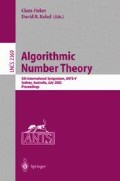Abstract
The Tate pairing has found several new applications in cryptography. This paper provides methods to quickly compute the Tate pairing, and hence enables efficient implementation of these cryptosystems. We also give division-free formulae for point tripling on a family of elliptic curves in characteristic three. Examples of the running time for these methods are given.
This author thanks Hewlett-Packard Laboratories, Bristol for support.
Access this chapter
Tax calculation will be finalised at checkout
Purchases are for personal use only
Preview
Unable to display preview. Download preview PDF.
References
P. S. L. M. Barreto, H. Y. Kim, B. Lynn and M. Scott, Efficient algorithms for pairing-based cryptosystems, Cryptology ePrint archive: Report 2002/008 (February 6, 2002).
I.F. Blake, G. Seroussi and N.P. Smart, Elliptic Curves in Cryptography, Cambridge University Press, 1999.
D. Boneh and M. Franklin, Identity-based encryption from the Weil pairing, in J. Kilian (ed.), Crypto 2001, Springer LNCS 2139 (2001) 213–229.
D. Boneh, B. Lynn and H. Shacham, Short signatures from the Weil pairing, in C. Boyd (ed.), Asiacrypt 2001, Springer LNCS 2248, (2001) 514–532.
G. Frey and H.-G. Rück, A remark concerning m-divisibility and the discrete logarithm in the divisor class group of curves, Math. Comp., 62, No. 206 (1994) 865–874.
G. Frey, M. Müller and H.-G. Rück, The Tate pairing and the discrete logarithm applied to elliptic curve cryptosystems, IEEE Trans. Inform. Theory, 45, no. 5 (1999) 1717–1719.
S. D. Galbraith, Supersingular curves in cryptography, in C. Boyd (ed.), Asi-ACRYPT 2001, Springer LNCS 2248 (2001) 495–513.
D. Hankerson, J. Hernandez and A. J. Menezes, Software implementation of elliptic curve cryptography over binary fields, Proceedings of CHES 2000, Springer LNCS 1965 (2000), 1–24.
A. Joux, A one round protocol for tripartite Diffie-Hellman, in W. Bosma (ed.), ANTS-IV, Springer LNCS 1838 (2000) 385–393.
N. Koblitz, An elliptic curve implementation of the finite field digital signature algorithm, in H. Krawczyk (ed.), Crypto’ 98, Springer LNCS 1462 (1998) 327–337.
V. Miller, Short programs for functions on curves, unpublished manuscript 1986.
A. J. Menezes, T. Okamoto and S. A. Vanstone, Reducing elliptic curve logarithms to logarithms in a finite field, IEEE Trans. Inf. Theory, 39, No. 5 (1993) 1639–1646.
R. Sakai, K. Ohgishi and M. Kasahara, Cryptosystems based on pairing, in SCIS 2000, Okinawa, Japan, January 2000.
J. H. Silverman, The arithmetic of elliptic curves, Springer GTM 106, 1986.
E. R. Verheul, Evidence that XTR is more secure than supersingular elliptic curve cryptosystems, in B. Pfitzmann (ed.), Eurocrypt 2001, Springer LNCS 2045 (2001), 195–210.
E. R. Verheul, Self-blindable credential certificates from the Weil pairing, in C. Boyd (ed.), Asiacrypt 2001, Springer LNCS 2248 (2001) 533–551.
Author information
Authors and Affiliations
Editor information
Editors and Affiliations
Rights and permissions
Copyright information
© 2002 Springer-Verlag Berlin Heidelberg
About this paper
Cite this paper
Galbraith, S.D., Harrison, K., Soldera, D. (2002). Implementing the Tate Pairing. In: Fieker, C., Kohel, D.R. (eds) Algorithmic Number Theory. ANTS 2002. Lecture Notes in Computer Science, vol 2369. Springer, Berlin, Heidelberg. https://doi.org/10.1007/3-540-45455-1_26
Download citation
DOI: https://doi.org/10.1007/3-540-45455-1_26
Published:
Publisher Name: Springer, Berlin, Heidelberg
Print ISBN: 978-3-540-43863-2
Online ISBN: 978-3-540-45455-7
eBook Packages: Springer Book Archive

